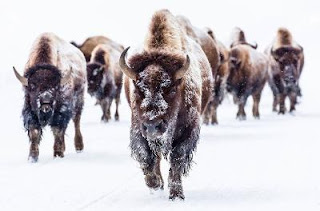As a youth growing up in central Kansas, I walked the tall grass prairies with a shotgun over my shoulder or grasped it in focused anticipation of the exploding rush of pheasants, prairie chickens, ducks and coveys of quail. During one of those prairie chicken hunts we came across a buffalo wallow that was carved out of the peak of one on the rolling flint hills that were home to around thirty-two million of these large mammals on the Great Plains alone at their peak, according to Steven Rinella’s book, American Buffalo.
But by the summer of 1872 the migrants that had begun to
settle the country had discovered that buffalo leather with elastic tendencies
was perfect for industrial belting and footwear. Literally thousands of buffalo hunters
converged on the Great Plains and began to decimate the great herds. Individual hunters reported killing up to 250
in a single day. Buffalo tongues were
considered a delicacy and shipped in wooden barrels on rail cars. The buffalo were almost hunted to extinction
within a dozen years. There was
unprecedented waste generated at the time and the incredulous natives suffered
the most, as the buffalo were their mainline sustenance.
The Native Indians had a sacred bond with the land and the
animals that helped to sustain their lives.
They used every part of a buffalo for both food and shelter. They would offer up a prayer of gratitude for
the spirit of the animal that gave up its life to sustain theirs. They constantly lived in nature and
consequently were one with nature. That
understanding has now been lost on modern men who forage for food at a local
supermarket and are totally removed from the animals whose flesh sustains them
in neatly wrapped packages.
As I was walking one crisp autumn morning on a quail hunt
along a stony creek bed, an anomaly appeared among the scattered rocks. I readjusted my twelve-gauge shotgun and bent
over to examine it. A probable heavy spring
rain had flooded the creek that meandered through these flint hills and had
unearthed a beautifully crafted flint arrowhead. That arrowhead had possibly been launched
onto the south wind, flying on a feathered wooden shaft in pursuit of watering
buffalo. I was struck by the bond that
now existed between the native warrior of the south wind and my own spirit
which fortuitously crossed this same sacred path that day. I still turn that fine crafted flint in my
hand every now and then to relive that bond.




No comments:
Post a Comment